In the current situation of increasingly complex manufacturing challenges, manufacturing optimization, digital transformation and talent shortage have become key issues. Manufacturing companies are under pressure to quickly adapt to fluctuations in market demand, integrate new technologies, and upskill their employees. Process Mining, as an efficient data analysis tool, can provide solutions in these areas.
In manufacturing optimization, Process Mining can help enterprises improve production efficiency and reduce resource waste by analyzing historical operation data to identify bottlenecks and inefficiencies in the production process, thereby improving overall manufacturing efficiency.
Generate operation flow charts in seconds to quickly analyze the bottlenecks of production processes
Through Process Mining, we can quickly convert the production process record data into a clear flow chart, allowing us to see the problems and opportunities in the operation process from different angles, and further optimize the allocation of resources.
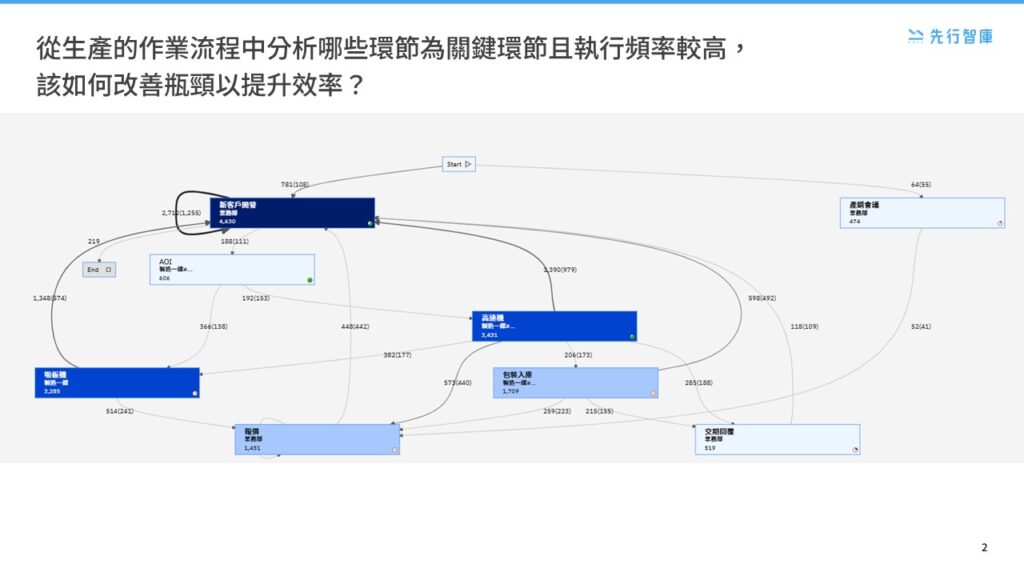
1. Business-side analysis:
- High frequency of new customer development and quotation: From
the business process in the diagram, it can be seen that the frequency of “new customer acquisition” and “quotation” is high. This means that the business people actually spend a lot of time developing new customers and less time negotiating with existing large customers. - Suggested measures: Through process exploration and analysis, it is recommended that enterprises strengthen new customer development tools, shorten development time, and improve the degree of automation of quotations, so that business personnel can focus more on maintaining relationships with high-value customers.
2. Process-side analysis:
- The high-speed machine in SMT has the highest number of executions:
From the perspective of the process side, it can be seen that the “high-speed machine” in SMT has the highest number of executions, which means that the possible reason is that the product has a high defect rate and leads to heavy work. - Suggested measures: It is recommended that enterprises further analyze the causes of the defect rate, such as the high defect rate that may be caused by design problems or improper adjustment of equipment parameters, so as to optimize the production process according to the manufacturing process, simultaneously strengthen the inspection and maintenance frequency of equipment, reduce the number of rework, and improve production efficiency.
Check the machine downtime from the average working hours, and then improve the machine utilization rate
In addition to using Process Mining to clearly grasp the execution frequency of the entire production process, enterprises can also use Process Mining as a tool to check the average working hours of each process and find out which links are far above the average.
For example, as can be seen from the figure, the average working hours of the “suction machine” are the longest, which may be due to the lack of materials in the production process, so through Process Mining, you can find out the bottlenecks in the production process, and put forward suggestions for improvement to improve the efficiency of these key links.
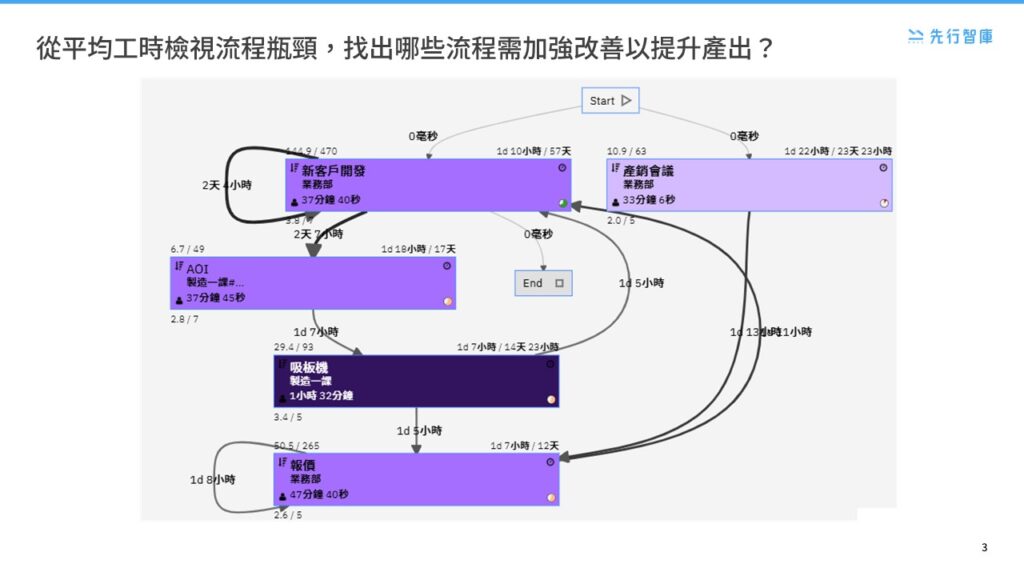
Optimize human resource allocation with data
Through Process Mining, we can compare the performance of “assistant engineers” and “engineers” in the project with numbers, so as to plan better work allocation, training direction, and reward system.

From the number of cases and the average case processing time in the graph, you can see the following specific applications:
- Analyze the current situation and identify bottlenecks: Based on the data differences between “assistant engineers” and “engineers”, companies can clearly understand the impact of each role in the process on the number of cases and the average handling time.
- Optimize resource allocation: Assign talents of different skill levels to the most appropriate process nodes. For example, an assistant engineer can take on more basic tasks while the engineer tackles higher-value work, improving overall process efficiency.
- Simulate and validate improvements: Through the comparison of different talents, enterprises can simulate putting different talents in different positions, and cross-verify whether the resource allocation is the most effective, so that enterprises can simulate and review the potential effects and risks before implementation, so as to avoid efficiency loss or waste of resources caused by incorrect manpower allocation.
- Cost control and efficiency improvement: Process mining can also combine working hours and salary data to calculate the average manpower output value of each person, for example, it can be seen from the figure that the average processing cost of each case for “assistant engineer” is 1364 yuan, while “engineer”.The average processing cost per case is 1,398 yuan, which shows that the number of cases completed by the two is similar, but the difference in processing time and cost indicates that the efficiency of each role in the process is different, and the cost-effectiveness of each resource allocation scheme can be evaluated through Process Mining, so as to maximize the allocation of human resources.
It can also be seen that the execution time and steps of each step in the process between assistant engineers and engineers can be different, and help managers optimize the allocation of human resources, and further reveal which process links can improve efficiency by increasing automation or resource reallocation. For example, for tasks that take longer or are more frequent, senior personnel can be appropriately assigned to reduce delays, while for junior personnel, targeted training can be provided to close the skills gap. With these insights, companies can improve process efficiency across the board and optimize manpower allocation.
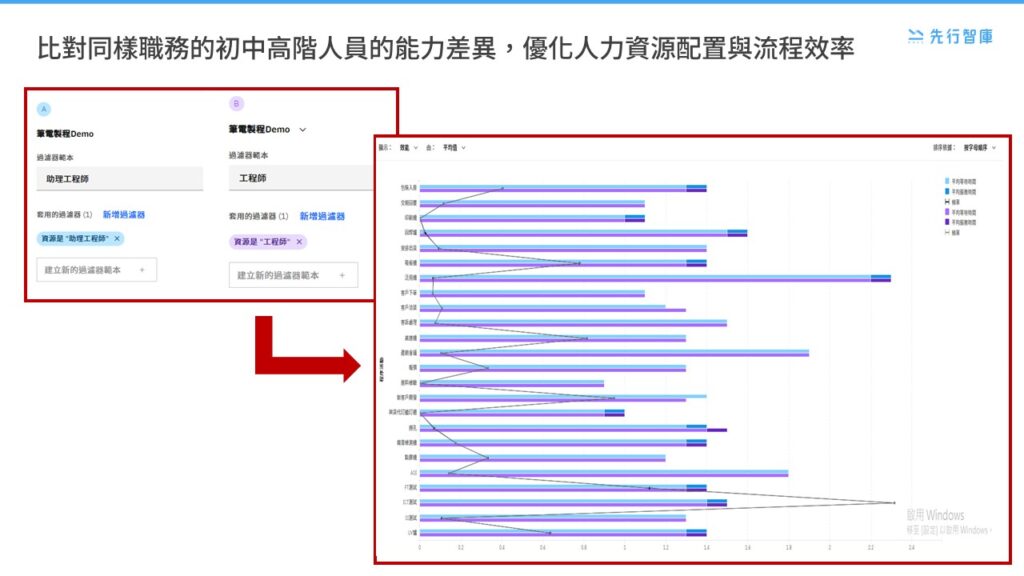
From the workflow operation diagram, optimize the dispatch and cross-departmental collaboration mechanism to create the company’s maximum synergy
Process Mining can help companies gain insight into human engagement at every stage of the process to find where they can streamline their workforce and resources. According to the operation relationship diagram in the figure below, you can see the division of labor and participation of different roles (such as deputy managers, assistants, and specialists) in each work link. Through this process, enterprises can systematically analyze how each worker node operates and how it relates to roles, and further uncover efficiencies in the process to improve the space.
For example, as you can see from the figure below, “Delivery Reply” and “Packing and Warehousing” may involve multiple roles, and most of them are repetitive jobs or unnecessary waiting times. Process Mining can quantify the contribution of each role in these steps and provide specific optimization recommendations, such as consolidating the responsibilities of certain roles or introducing automation tools to reduce human input. At the same time, the diagram clearly shows the role collaboration between the business department and the manufacturing department, which provides an intuitive reference for enterprises to optimize cross-departmental processes. With these insights, companies can redesign processes to reduce wasted labor, improve overall operational efficiency, and ensure optimal resource allocation.
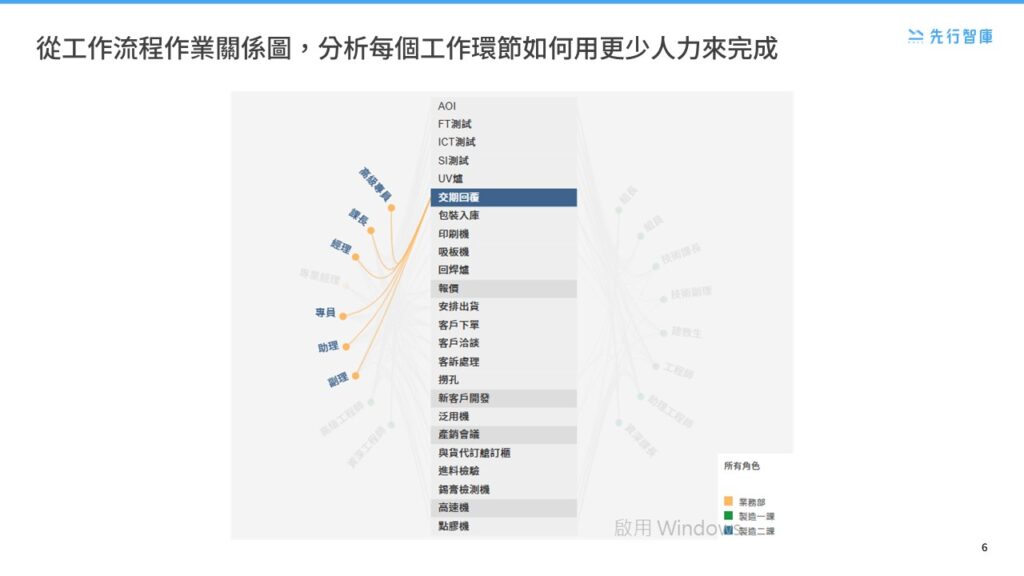
Data-based comparison of manufacturing efficiency and cost-effectiveness in different plants
The results of this graph show the difference in efficiency between the Kunshan and Taoyuan factories when producing the same type of laptop. The filter in the upper left corner shows the analysis scope of the two plants.
The Kunshan plant processed 102 cases with an average delivery time of 29 days and 1 hour and an average cost per unit of EUR 22,724.51, compared to 74 cases in Taoyuan with a shortened delivery time of 20 days and 6 hours and a cost per unit of EUR 17,259.46.
The bar chart in the middle compares the efficiency performance of the two factories in AOI testing, ICT testing, packaging and warehousing, and other processes. The Kunshan plant took a long time in multiple processes, such as AOI testing and packaging, indicating process bottlenecks.
The flowchart on the lower right shows the overall process from AOI testing to final customer complaint handling. The Taoyuan plant has a more compact process and high resource utilization, and it was recommended that the Kunshan plant reduce lead times and costs by optimizing test equipment, reducing the number of rework, and introducing process automation.
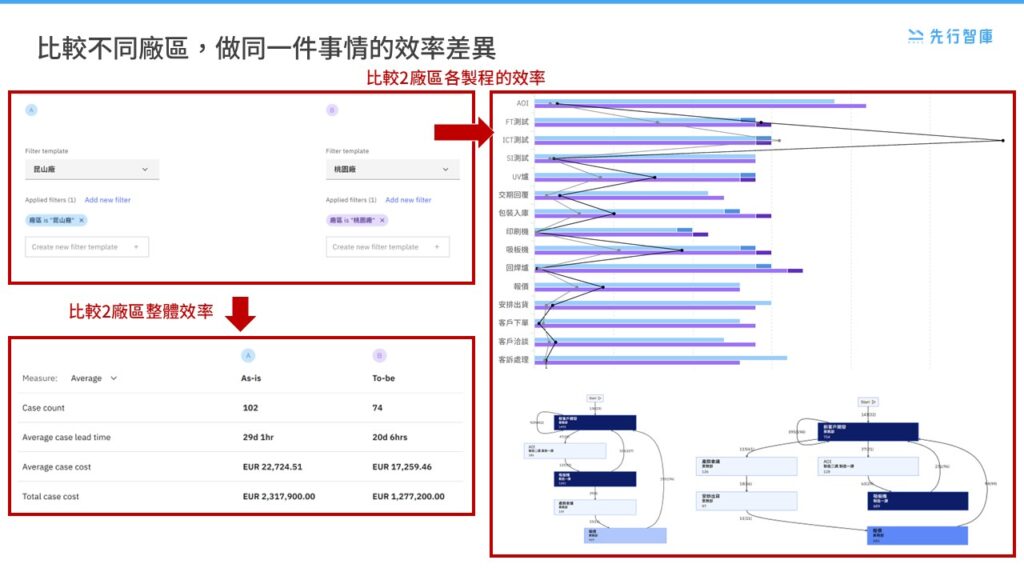
In the face of market volatility and talent shortages in the manufacturing industry, Process Mining has become a key tool to improve efficiency. By analyzing historical data, it identifies process bottlenecks and optimizes resource allocation.
Benefit:
- Productivity improvement: Analyze historical data, identify process problems with high heavy work frequency, optimize equipment maintenance and production processes, and reduce defect rates and resource waste.
- Workforce optimization: Enterprises can analyze the differences in performance and work of different roles, and simulate putting different talents in different positions to optimize the allocation of human resources.
- Data-driven decision-making: Combine working hours and payroll data to accurately evaluate the efficiency of resource allocation to ensure cost control and maximize output.
- Process automation and collaboration improvement: Quantify the efficiency of cross-departmental collaboration, identify repetitive tasks and delays, and propose automation and process consolidation suggestions to improve operational efficiency.
Process Mining covers production processes, business processes, and human resource allocation, helping enterprises achieve comprehensive efficiency improvement and digital transformation, and becoming an important tool to meet challenges.
KSCC is a management consulting company in Taiwan. Our services include corporate in-house training, consulting, and leadership management.For more information about our corporate services, please feel free to visit our website: https://kscthinktank.com.tw/custom-training/
